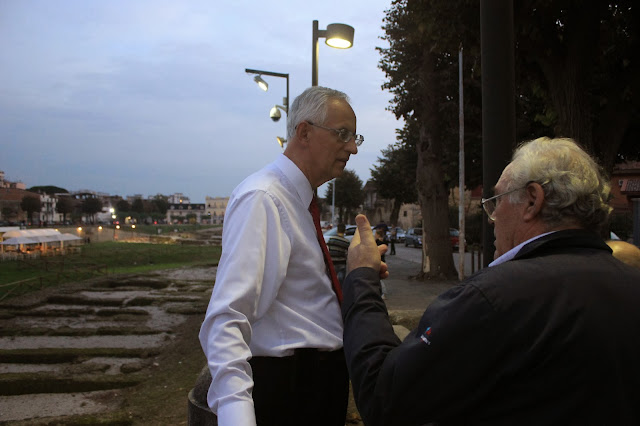The Anfiteatro Capuano or Ampitheatre of Capua is the second largest amphitheater (or colosseum) of the Roman world. Many of the gladiators trained here before fighting in the colosseum in Rome. This colosseum is built adjacent to the ruins of an even older amphitheater where Spartacus trained. Adjacent to that are the ruins of an ancient temple called the Temple of the Nymphs because it had a pool inside it. The site even includes some ancient Etruscan ruins. The colosseum in Rome was the largest colosseum and the most famous colosseum, but I liked this colosseum better because of the integrity of the cages underground where the gladiators and animals were kept.
We had been all through the colosseum and were walking on the outside when a couple of older gentlemen (I say that tongue in cheek) started talking to Michael in Italian and explained all the details of the two colosseums and the temple and pointed out a bunch of things we hadn't known. He in turn translated it to me and the senior couple that were with us. At the end of the evening, they gave him two books about the area and invited us to return the next time we are in town and they will give us a tour of another area. In return, Michael gave them a pamphlet on LDS temples and a Book of Mormon.
 |
| Ampitheatre of Capua |
 |
| Colosseum cat |
 |
| Ampitheatre of Capua in back with footings of original amphitheater in front where Spartacus trained. |
 |
| Steam room originally built by Etruscans. |
 |
| Keystone |
 |
| Arena of Colosseum in Capua |
 |
| Typical statue with only one arm and one leg. |
 |
| Hercules |
 |
| Michael with historian and foundation of Spartacus colosseum |
 |
| Outside of nymph temple |
 |
| Nymph temple - each big white rock supported a large pillar |
 |
| Foundation of Spartacus colosseum |
























































































No comments:
Post a Comment